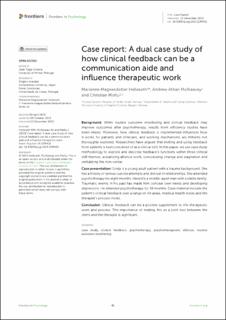| dc.contributor.author | Helleseth, Marianne Magnesdotter | |
| dc.contributor.author | Mcaleavey, Andrew Athan | |
| dc.contributor.author | Moltu, Christian | |
| dc.date.accessioned | 2024-04-11T07:49:14Z | |
| dc.date.available | 2024-04-11T07:49:14Z | |
| dc.date.created | 2024-01-12T12:21:34Z | |
| dc.date.issued | 2023 | |
| dc.identifier.citation | Frontiers in Psychology. 2023, 14 . | en_US |
| dc.identifier.issn | 1664-1078 | |
| dc.identifier.uri | https://hdl.handle.net/11250/3125965 | |
| dc.description.abstract | Background: While routine outcome monitoring and clinical feedback may improve outcomes after psychotherapy, results from efficiency studies have been mixed. Moreover, how clinical feedback is implemented influences how it works for patients and clinicians, and working mechanisms are hitherto not thoroughly explored. Researchers have argued that inviting and using feedback from patients is best conceived of as a clinical skill. In this paper, we use case study methodology to explore and describe feedback’s functions within three clinical skill themes: actualizing alliance work, concretizing change and stagnation and verbalizing the non-verbal.
Case presentation: Sonja is a young adult patient with a trauma background. She has a history of serious suicide attempts and distrust in relationships. She attended psychotherapy for eight months. Harald is a middle-aged man with a stable family. Traumatic events in his past has made him conceal own needs and developing depression. He attended psychotherapy for 19 months. Case material include the patient’s clinical feedback over a range of life areas, medical health notes and the therapist’s process notes.
Conclusion: Clinical feedback can be a positive supplement to the therapeutic work and process. The importance of making this as a joint tool between the client and the therapist is significant. | en_US |
| dc.language.iso | eng | en_US |
| dc.publisher | Frontiers Media S.A. | en_US |
| dc.rights | Navngivelse 4.0 Internasjonal | * |
| dc.rights.uri | http://creativecommons.org/licenses/by/4.0/deed.no | * |
| dc.title | Case report: A dual case study of how clinical feedback can be a communication aide and influence therapeutic work | en_US |
| dc.type | Peer reviewed | en_US |
| dc.type | Journal article | en_US |
| dc.description.version | publishedVersion | en_US |
| dc.rights.holder | © 2023 Helleseth, McAleavey and Moltu | en_US |
| dc.source.pagenumber | 13 | en_US |
| dc.source.volume | 14 | en_US |
| dc.source.journal | Frontiers in Psychology | en_US |
| dc.identifier.doi | 10.3389/fpsyg.2023.1199431 | |
| dc.identifier.cristin | 2225334 | |
| dc.source.articlenumber | 1199431 | en_US |
| cristin.ispublished | true | |
| cristin.fulltext | original | |
| cristin.qualitycode | 1 | |

